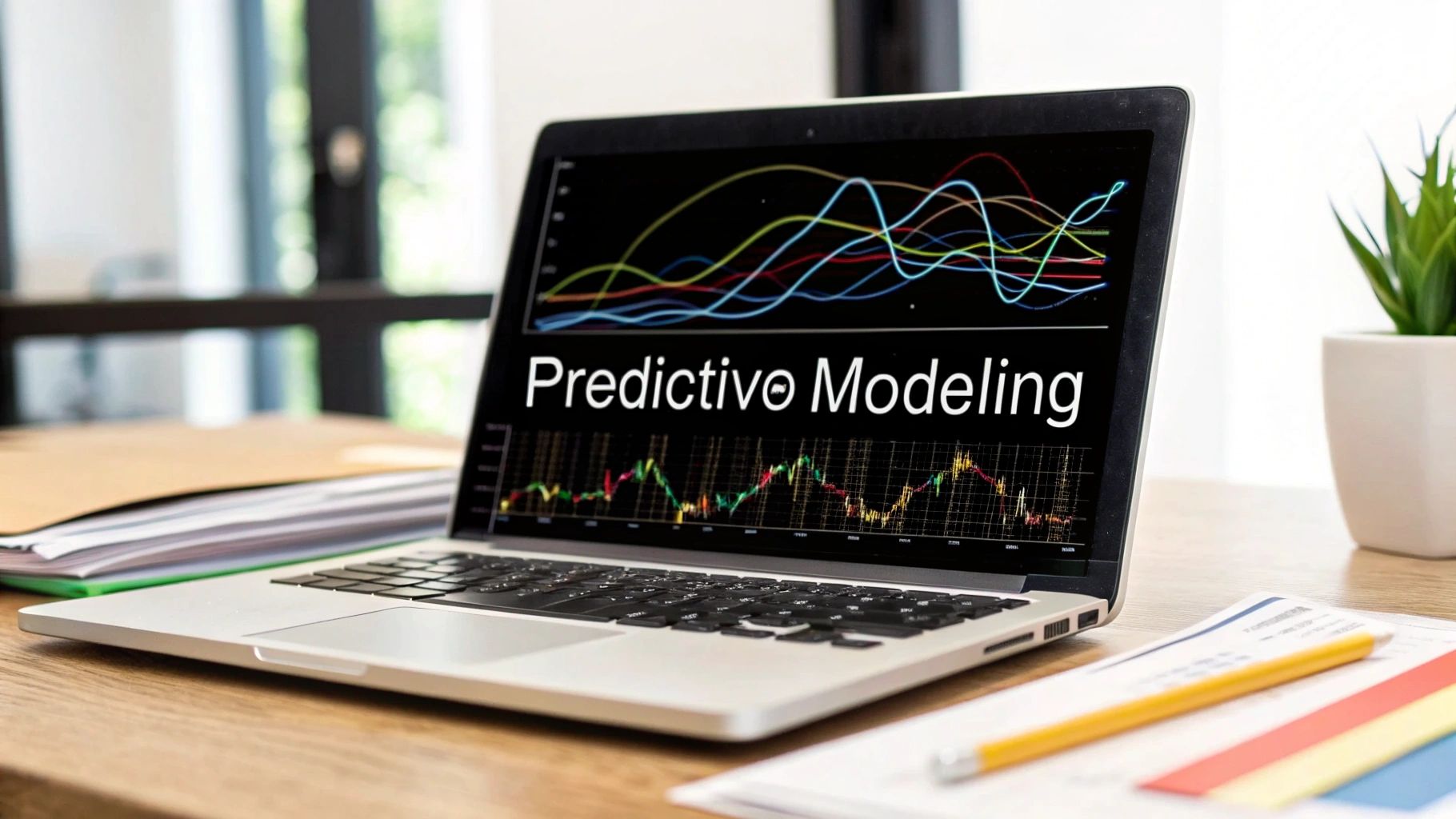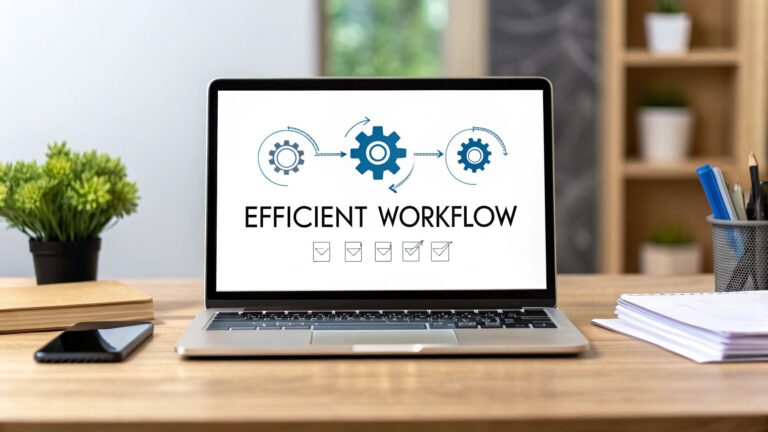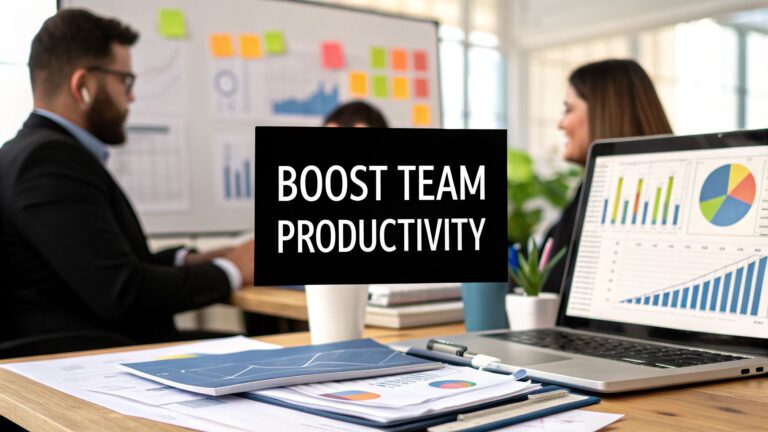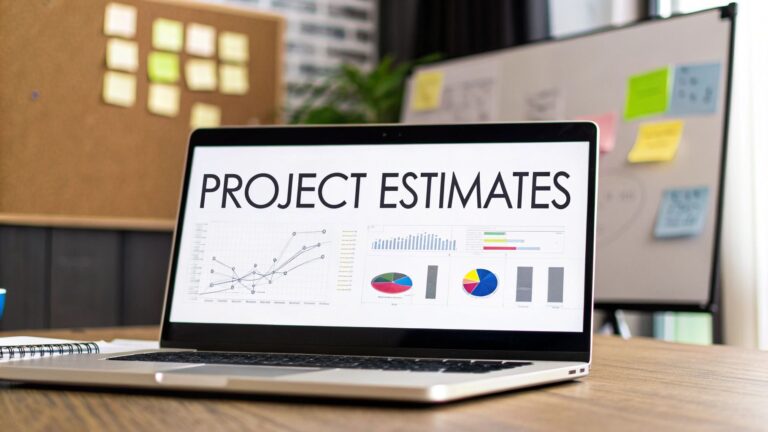What Is Predictive Modeling? A Practical Guide
So, what exactly is predictive modeling when you strip away the jargon? At its heart, it's the process of using the data you already have to make a highly educated guess about the future.
Think of it like being a detective for your business. Instead of solving a crime that's already happened, you're piecing together clues from past events—customer behavior, sales figures, market trends—to predict what's going to happen next. It allows you to anticipate outcomes, not just react to them.
The Real Power of a Good Forecast
Predictive modeling is where statistics meets modern computing power, using techniques like machine learning to uncover hidden patterns in your data. It goes way beyond looking at last year's numbers and hoping for the best. It finds the subtle, often invisible, relationships between different variables to figure out what's really driving results.
Let’s use a practical example. Imagine you run an online store and want to plan for the upcoming holiday rush. The old-school way would be to just look at last year's sales and order a similar amount of inventory.
But a predictive model digs much, much deeper. It might analyze:
- Recent sales spikes for specific product categories.
- Which marketing campaigns are driving the most traffic.
- What people are saying about your products on social media.
- Even how a competitor's recent price drop might affect your sales.
By connecting all these dots, the model gives you a forecast that’s forward-looking, not just a reflection of the past. You're no longer just guessing; you're making a calculated decision that helps you stock the right products at the right time.
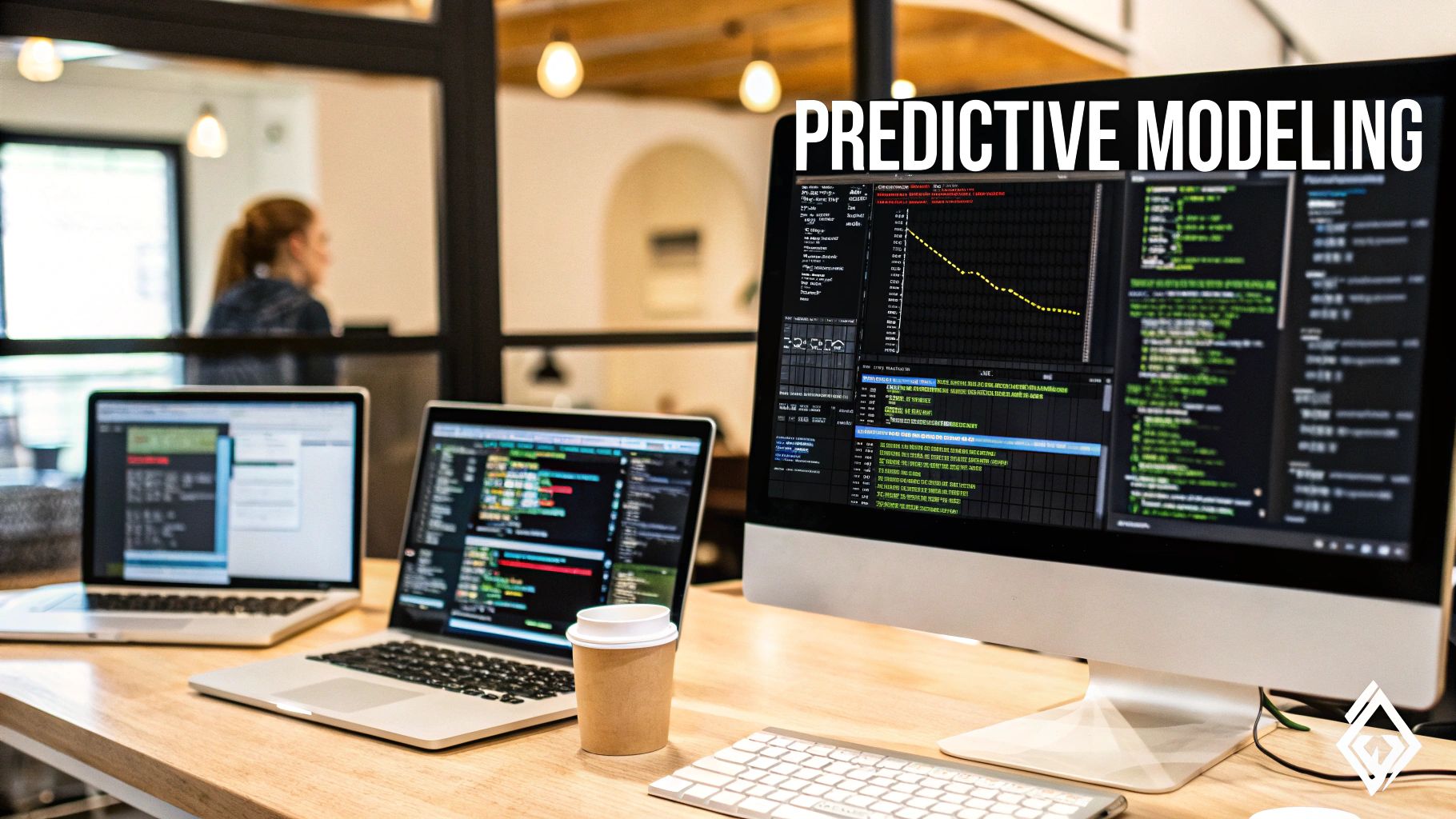
Breaking It Down
To really get a feel for predictive modeling, it helps to understand its core components. This isn't some black-box magic; it's a structured approach for turning raw data into actionable foresight.
The goal isn't just to predict what will happen, but to understand why it will happen. That's where the real power lies—it gives you the insight needed to actually influence future outcomes.
To make this crystal clear, let's break down the fundamentals into a simple table. This gives a great high-level view before we dive into the nitty-gritty of how these models are actually built.
Predictive Modeling at a Glance
This table simplifies the core ideas behind predictive modeling, showing how its different pieces fit together in the real world.
| Component | Simple Explanation | Example |
|---|---|---|
| Who Uses It | Any organization trying to make smarter decisions, from startups to large corporations. | A hospital predicts which patients are at a high risk of readmission to provide better preventative care. |
| What It Does | It takes historical data, finds patterns, and creates a mathematical "rule" to forecast future events. | A streaming service predicts which shows a user will likely enjoy based on their viewing history. |
| Why It's Used | To minimize risks, find new opportunities, and operate more efficiently. | An airline uses it to set ticket prices based on predicted demand for a particular flight. |
| How It Works | It uses statistical algorithms and machine learning to "learn" from data and make predictions. | An algorithm is trained on thousands of past customer support tickets to automatically categorize new ones. |
Ultimately, this framework provides a reliable way to turn information you already have into a strategic advantage for the future.
How Predictive Models Actually Work
At its core, predictive modeling isn't some kind of digital magic. It's a disciplined process, a lot like training a new employee to spot a specific pattern. You wouldn't just hand them a stack of random files and hope for the best, right? You’d give them a clear objective, provide relevant examples, and then test their understanding. Building a predictive model follows that same logical path, moving from a simple question to a powerful, data-driven forecast.
It all kicks off with a crystal-clear question. A model is only as useful as the problem it's built to solve. A vague goal like "boost sales" is a non-starter. A much better, more targeted question would be, "Which of our current customers are most likely to churn in the next 90 days?" Now that's a target we can aim for.
The specific thing you’re trying to predict—in this case, customer churn—is called the target variable. Everything else, all the clues and data points you use to make that prediction, are called features. For our churn example, features might include things like the customer's purchase frequency, their recent interactions with support, or how long they've been with the company.
Getting the Raw Materials Ready
With a clear goal set, it's time to gather the data. This means collecting all the historical information you have that contains both your features and your target variable. This data is often scattered across different systems—your CRM, website analytics, payment processor, you name it. Pulling it all together is a critical step, and following solid data integration best practices is key to making sure everything is consistent and reliable from the get-go.
Let's be honest, raw data is almost always a mess. You'll find missing values, duplicate entries, and all sorts of inconsistencies. That’s why data cleaning is one of the most important parts of the entire process. It’s all about fixing those errors and standardizing the formats so your model learns from clean, high-quality information. If you feed a model "dirty" data, you're just teaching it bad habits.
Training and Testing: The Learning Phase
Once your data is clean, you get to the heart of the matter: training the model. You’ll typically split your historical dataset into two chunks: a large training set and a smaller testing set.
-
Training the Model: The algorithm gets to work on the training data. It meticulously analyzes the relationships between the features (like customer behavior) and the target variable (whether they actually churned) to find patterns. Think of this as the "study session," where the model builds its internal logic.
-
Testing the Model: After it's been trained, the model faces its final exam. It's given the testing data—which it has never seen before—and asked to make predictions. We then compare its predictions to the actual outcomes in the test set to see how accurate it is. This tells us if it’s ready for the real world.
A common pitfall here is "overfitting." This happens when a model performs perfectly on the training data but bombs the test. It essentially memorized the answers instead of learning the concepts, making it useless for predicting future outcomes.
The incredible value of this process is why the market is exploding. The global predictive analytics market is expected to jump from USD 23.7 billion in 2025 to a massive USD 82.35 billion by 2030. This growth is all about the increasing demand for making smarter, data-backed decisions. As you can see in this predictive analytics market report, companies are increasingly looking for all-in-one platforms that can handle the entire workflow.
This structured approach—from asking the right question to validating the results—is what turns raw, messy data into a reliable forecasting engine.
Exploring Common Predictive Modeling Techniques
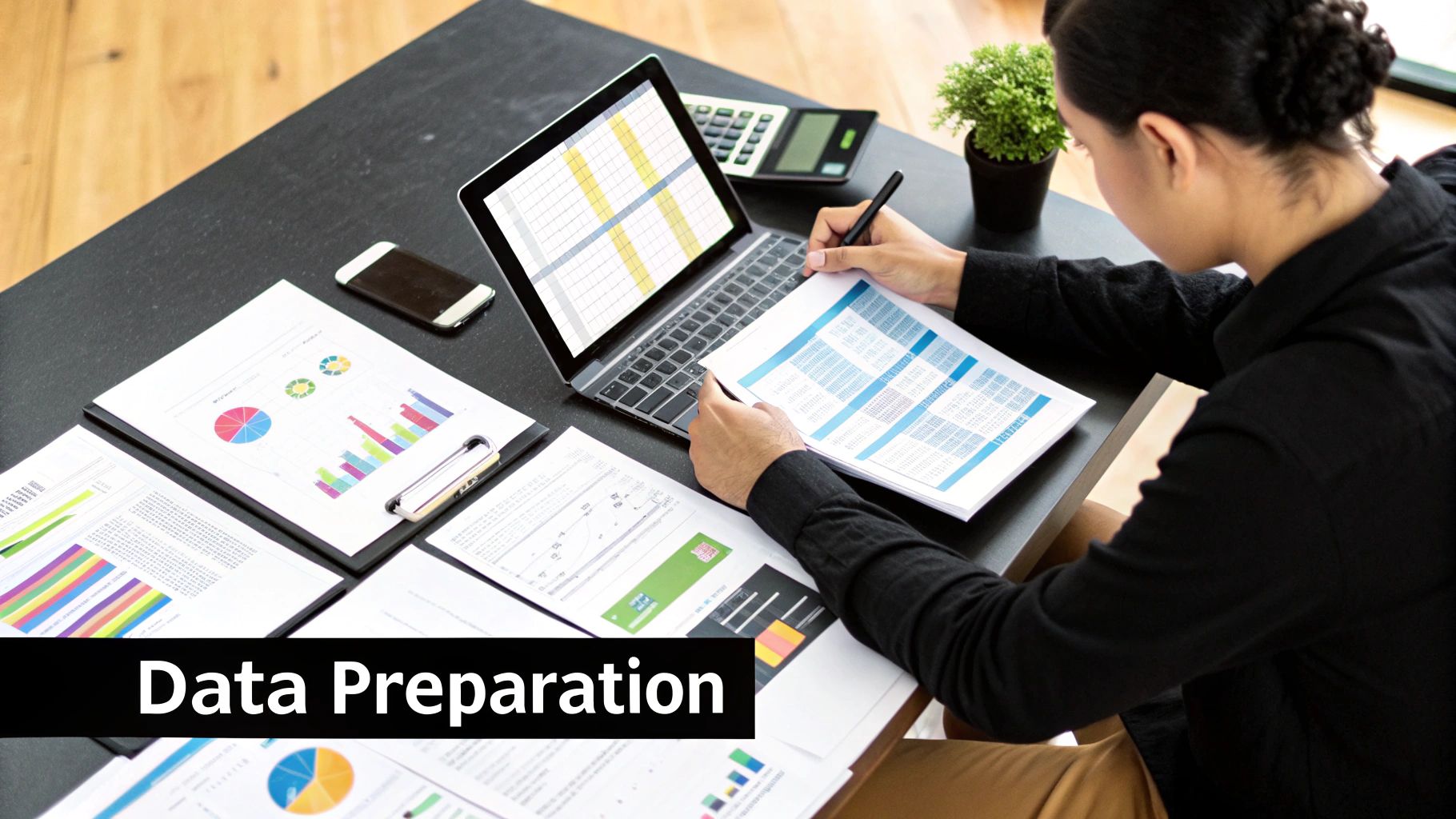
Knowing how to build a predictive model is only half the battle. The other half is knowing which tool to pull out of the toolbox for the job at hand. Predictive modeling isn't a one-size-fits-all field; it’s more like a mechanic’s workshop stocked with specialized instruments. You wouldn't use a sledgehammer to fix a watch, right?
The good news is you don't need a Ph.D. in statistics to get the gist of it. Most predictive models belong to one of two big families, categorized by the type of question they’re built to answer. Once you understand these two groups, you’ll be able to spot the right approach for nearly any business problem you come across.
These two primary families are classification models and regression models. Each has a very different job, and knowing which is which is the first real step to making predictive analytics work for you.
Classification Models: Predicting a Category
Classification models are what you reach for when the answer you need is a category, a label, or a simple "yes or no." The output isn't a number—it’s a choice. These models are all about sorting data into predefined groups.
Think about your email inbox. A classification model is constantly working behind the scenes, deciding if each new message is "spam" or "not spam." When you swipe your credit card, a bank’s model instantly decides if the transaction is "fraudulent" or "legitimate." In both scenarios, the model is assigning a clear, distinct label.
One of the most intuitive classification models is the Decision Tree.
It works a lot like a game of "20 Questions." The model starts by asking a broad question about your data, and based on the answer, it drills down with more specific questions until it lands on a final conclusion. This step-by-step process makes them incredibly easy to visualize and explain, which is a huge plus.
Classification models are the organizers of the data world. They bring order to chaos by filtering, sorting, and flagging information based on patterns they've learned, giving you a clear, categorical answer.
Regression Models: Predicting a Number
While classification models sort things into neat piles, regression models are all about predicting a continuous number. If your question starts with "how much?" or "how many?", you're squarely in regression territory. These are the workhorses for financial forecasting, sales projections, and any other task where you need a specific number as your answer.
A classic example is predicting a home’s selling price. A regression model would look at features like square footage, the number of bedrooms, and the neighborhood to estimate a precise dollar amount. Likewise, a retail company might use a regression model to forecast exactly how many units of a new product it will sell next month.
The most fundamental technique here is Linear Regression.
This model finds the best straight-line relationship between your inputs and the final output. It might sound simple, but it’s an incredibly powerful way to understand how one factor influences another. For example, it can help you answer critical business questions like, "For every extra $1,000 we put into our marketing budget, what’s the expected increase in revenue?"
Comparing Common Predictive Modeling Techniques
So, how do you choose? It all comes down to your goal. A model built to predict if a customer will leave (a classification problem) is completely wrong for forecasting next quarter's revenue (a regression problem).
This table gives a quick side-by-side look at the foundational models we've discussed.
| Model Type | Best Used For | Example Application | Key Advantage |
|---|---|---|---|
| Classification (Decision Tree) | Answering "yes/no" or "which category?" questions. | Determining if a loan application should be approved or denied. | Its structure is easy to interpret and explain to non-technical stakeholders. |
| Regression (Linear Regression) | Predicting a specific numerical value. | Forecasting the number of website visitors for the upcoming week. | It clearly shows the strength and direction of the relationship between variables. |
Of course, the world of predictive modeling goes much deeper. Data scientists also work with sophisticated techniques like Neural Networks, which are modeled after the human brain to find incredibly complex patterns. They also use Ensemble Models, which combine predictions from multiple different models to arrive at a single, more accurate result—the "wisdom of the crowd" approach.
Ultimately, every technique shares the same core purpose: to transform your historical data into a reliable glimpse of the future. Whether you need to sort customer reviews or pin down inventory needs, there's a model out there designed to give you that powerful insight.
How Predictive Modeling Drives Real World Results
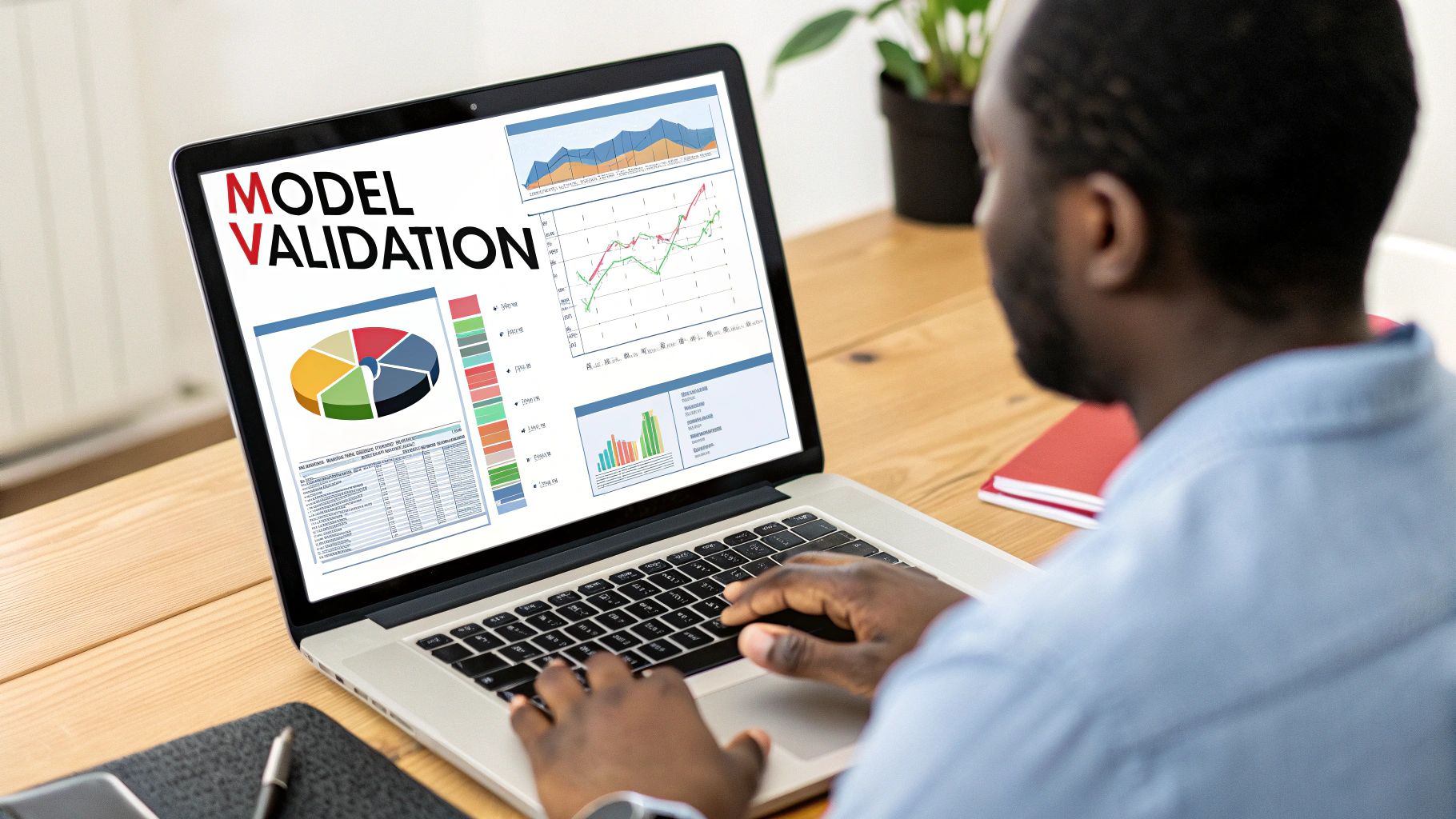
The theory behind predictive modeling is one thing, but seeing it work in the real world is where you grasp its true power. This isn't some abstract concept for data scientists; it's a practical tool that solves real problems and gives businesses a serious competitive edge.
Predictive models are working behind the scenes everywhere, from the products you buy online to the healthcare you receive. By connecting a clear business goal to the right data, companies are shifting from just reacting to problems to proactively shaping their future.
Let’s look at how this plays out in some of the world's biggest industries.
Transforming Retail and Ecommerce
The modern retail experience is practically built on a foundation of predictive modeling. Think about the last time you were on a major e-commerce site. That "products you might like" section wasn't a lucky guess.
It was a sophisticated model analyzing your clicks, past purchases, and the behavior of thousands of other shoppers like you to predict what you'd want next. This doesn't just make your shopping experience better—it directly boosts sales by showing you things you might have missed. It’s a win-win, driven by data.
Beyond recommendations, retailers lean on predictive models for:
- Inventory Management: Forecasting demand for certain products to avoid the dual costly mistakes of overstocking or running out of hot items.
- Customer Churn Prediction: Identifying customers who are likely to leave, which allows the company to step in with targeted offers to keep them.
- Price Optimization: Adjusting prices on the fly based on demand, what competitors are doing, and current inventory levels to maximize profit.
Securing the World of Finance
The entire financial industry runs on managing risk, making it the perfect playground for predictive modeling. Banks and financial institutions process billions of transactions every single day, and being able to forecast outcomes is essential for survival, let alone growth.
One of its most important jobs is in fraud detection. The moment you swipe your credit card, a model analyzes dozens of variables in an instant—the transaction amount, location, time, and your typical spending patterns. If something seems off, the model flags it as potentially fraudulent in milliseconds, protecting both you and the bank.
Predictive modeling is a core part of the predictive analytics market. The banking and finance sector is a prime example of its impact, growing steadily at a CAGR of nearly 16%. Models there are essential for everything from fraud detection to credit risk evaluation.
Another cornerstone is credit scoring. Models sift through an applicant's financial history to predict how likely they are to repay a loan. This gives lenders the ability to make faster, smarter, and more consistent decisions. In a similar vein, businesses apply these same principles to sales. In fact, understanding what is sales forecasting is all about predicting future revenue to better plan for growth.
Enabling Proactive Healthcare
In healthcare, the stakes couldn't be higher, and the potential for predictive modeling to save lives is immense. By analyzing patient data, models can identify people at high risk for diseases long before they show any symptoms, opening the door for truly proactive care.
For instance, a model could analyze a patient's electronic health records, family history, and lab results to calculate their risk of developing diabetes. This gives doctors the heads-up they need to recommend lifestyle changes or start early treatment, dramatically improving the outcome.
Hospitals also use predictive models to run more smoothly. They can forecast patient admission rates to get staffing and bed allocation right, which means shorter wait times and better care for everyone. By predicting which patients are most likely to be readmitted after going home, hospitals can provide extra follow-up care, preventing stressful and expensive return visits.
Building Your First Predictive Model Step By Step
Reading about predictive modeling is one thing, but actually building a model is where the real learning happens. It might sound daunting, but the whole process breaks down into a logical workflow. Think of it as a roadmap that takes you from a simple business question to a powerful forecasting tool.
Let's walk through the five key stages. This is a clear, beginner-friendly guide focused on the essential actions you need to take to get from an idea to a working predictive model.
Step 1: Define Your Goal
Before you touch any data or write a single line of code, you need to know exactly what you're trying to achieve. A fuzzy goal like "improve our business" is a dead end. You need a specific, measurable question that the model can actually answer.
- Weak Goal: "We want to understand our customers better."
- Strong Goal: "Which customers who signed up in the last six months are most likely to cancel their subscription in the next 30 days?"
This clarity is everything. It shapes every single decision you'll make, from what data you collect to which algorithm you use. A well-defined problem is already halfway solved.
Step 2: Prepare Your Data
Data is the fuel for your model. The quality of that fuel directly impacts your results. This step is all about gathering relevant historical information from your CRM, sales records, website analytics, and any other source you have.
But raw data is almost never ready to use. You'll need to clean it up by handling missing values, getting rid of duplicates, and making sure the formatting is consistent. This is often the most time-consuming part of the entire project, but you can't skip it. Feeding a model "dirty" data is like trying to teach someone with a textbook full of typos—the results will be completely unreliable.
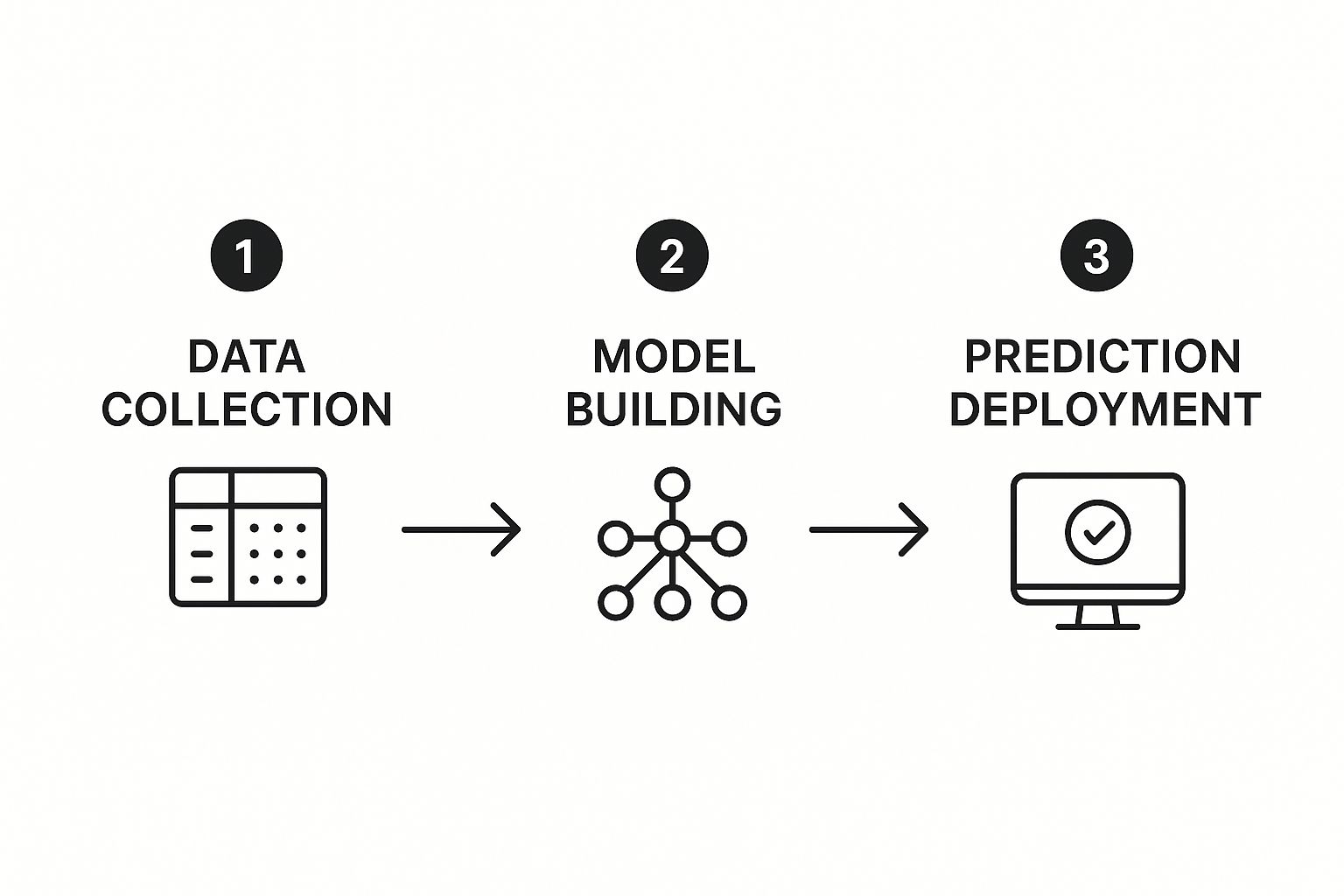
This workflow shows the logical path from high-quality data to a model that's actually useful in the real world.
Step 3: Choose the Right Model
With clean data ready to go, it's time to pick the right algorithm for the job. As we covered earlier, the choice comes right back to your goal.
- If you’re predicting a category (like "will churn" vs. "will not churn"), you'll need a classification model.
- If you're predicting a number (like "next month's sales"), you'll want a regression model.
For beginners, there are plenty of user-friendly tools. Python libraries like Scikit-learn make it easy to try out different models without being a coding genius. If you're looking for a hands-on starting point, resources like a marketer's guide to Google AI Studio offer a great look at platforms that are built for accessibility.
The best model isn't always the most complex one. A simpler model that you can easily understand and explain is often far more valuable than a complicated "black box" that no one trusts.
Step 4: Train and Test Your Model
This is where the magic happens—it's when your model actually learns. You'll split your data into two piles: a large training set and a smaller testing set. The model crunches through the training data, looking for patterns and connections between your inputs and the outcome you want to predict.
After it's trained, you unleash it on the testing data, which it has never seen before. This is the moment of truth. By comparing its predictions against the actual outcomes in the test set, you can measure how accurate it is. This step is non-negotiable; it proves your model can apply what it learned to new, real-world information and isn't just "memorizing" the training examples. For more on the big picture of creating intelligent systems, our guide on how to create an AI program gives a broader view of the development process.
Step 5: Put Your Model to Use
At the end of the day, a model sitting on a hard drive is useless. The final step is deployment, where you integrate it into your daily business operations to start making real-time predictions.
This could mean adding it to a dashboard for your sales team, plugging it into your marketing automation software, or using it to power the product recommendations on your website. The goal is to get its insights into the hands of the people who can act on them.
Here is the rewritten section, designed to sound natural and human-written:
Where Predictive Modeling Is Headed
Predictive modeling isn't standing still. Far from it. Fueled by breakthroughs in artificial intelligence and the sheer volume of data we now generate, this field is constantly moving forward. The future isn't just about more powerful models; it's about models that are easier to use and more deeply woven into how businesses actually run.
This shift means that understanding how to look into the future with data is no longer a skill reserved for data scientists. It's quickly becoming essential for anyone in marketing, finance, or leadership who wants to make smarter decisions.
One of the biggest game-changers on the horizon is Automated Machine Learning (AutoML). Think of AutoML platforms as a way to automate the heavy lifting of building a model. They handle the complex, tedious tasks, opening the door for teams without a dedicated data scientist to start turning their data into valuable forecasts.
A Rapidly Growing Market
You don't have to look far to see the economic ripples. The predictive analytics market is already valued at around USD 17.5 billion, but it's expected to skyrocket past USD 100 billion by 2034.
That's a staggering compound annual growth rate of 21.4%, a clear sign that organizations are betting big on this technology. You can dig into the numbers yourself in this comprehensive market research on predictive analytics. The takeaway is simple: being able to forecast what's next is moving from a "nice-to-have" advantage to a core business necessity.
The Push for Fairness and Trust
As these models play a bigger role in our lives—deciding everything from loan approvals to medical treatments—a serious conversation about ethics is taking center stage. The future of predictive modeling has to be built on a foundation of algorithmic fairness and transparency.
It’s no longer enough for a model to be accurate. It also has to be fair and explainable. The work of identifying and correcting bias in our data is becoming just as critical as the algorithm’s predictive power.
This means actively developing ways to find and fix biases tied to race, gender, and other sensitive attributes. The most forward-thinking companies are already making responsible AI a priority, knowing that trust is essential for building models that produce equitable and defensible outcomes.
At the end of the day, as our world becomes more data-driven, the ability to master predictive modeling will separate the leaders from the laggards. It’s the key to getting ahead of trends, streamlining operations, and finding clarity in a complex world.
Got Questions? Let's Talk Predictive Modeling
Even after getting the hang of the basics, a few questions always pop up when people start digging into predictive modeling. Let's clear up some of the most common ones.
What’s the Difference Between Predictive Modeling and Machine Learning?
This one trips a lot of people up, but it's simpler than it sounds. Think of predictive modeling as the overall goal, and machine learning as one of the powerful tools you use to get there.
Predictive modeling is the whole strategy: you want to use past data to make a smart guess about the future. Machine learning is the engine that does the heavy lifting, using specific algorithms to sift through that data, find patterns, and build the actual forecasting model.
In short, machine learning is a how, while predictive modeling is the what.
How Much Data Do I Really Need for a Predictive Model?
There’s no magic number here. The answer is almost always "it depends," but the key is quality over sheer quantity. The amount of data you'll need hinges on how complex your problem is and the type of algorithm you choose.
- For simpler tasks, like figuring out which customers might leave based on a few key behaviors, a few thousand clean records could do the trick.
- For complex problems, such as image recognition or understanding human language, you're talking about a much bigger scale. These models often need millions of examples to learn the nuances.
What matters most is that your data is clean, relevant, and has enough examples for the model to find a reliable pattern.
A lot of teams get stuck thinking they need a perfect, massive dataset before they can even start. The truth is, it's often better to start with the data you have, build an initial model, and then figure out where the gaps are.
What Are the Biggest Headaches in Predictive Modeling?
You might think the hardest part is the complex math, but that's rarely the case. The real challenges almost always circle back to one thing: the data.
Here are the top three hurdles you'll likely face:
- Getting Data Quality Right: It’s the old "garbage in, garbage out" rule. A model is only as good as the data it’s trained on. Inaccurate, messy, or incomplete information will only lead to bad predictions.
- Picking the Right Features: You need to figure out which pieces of information actually matter. Throwing irrelevant data into the mix just creates noise and can seriously confuse the model, making it less accurate.
- Avoiding "Overfitting": This is a classic trap. It happens when a model learns the training data too well—it basically memorizes it. The model looks brilliant on paper but fails spectacularly when it sees new, real-world data. It's like a student who crams for a test but doesn't actually understand the subject.
Ready to stop reacting and start predicting? MakeAutomation specializes in implementing AI and automation frameworks that turn your business data into a powerful forecasting engine. We can help you build and deploy predictive models to streamline lead generation, optimize operations, and drive scalable growth. Learn how to put your data to work today.

